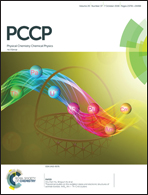Tuning nuclear depolarization under MAS by electron T1e†
Abstract
The Cross-Effect (CE) Dynamic Nuclear Polarization (DNP) mechanism under Magic Angle Spinning (MAS) induces depletion or “depolarization” of the NMR signal, in the absence of microwave irradiation. In this study, the role of T1e on nuclear depolarization under MAS was tested experimentally by systematically varying the local and global electron spin concentration using mono-, bi- and tri-radicals. These spin systems show different depolarization effects that systematically tracked with their different T1e rates, consistent with theoretical predictions. In order to test whether the effect of T1e is directly or indirectly convoluted with other spin parameters, the tri-radical system was doped with different concentrations of GdCl3, only tuning the T1e rates, while keeping other parameters unchanged. Gratifyingly, the changes in the depolarization factor tracked the changes in the T1e rates. The experimental results are corroborated by quantum mechanics based numerical simulations which recapitulated the critical role of T1e. Simulations showed that the relative orientation of the two g-tensors and e–e dipolar interaction tensors of the CE fulfilling spin pair also plays a major role in determining the extent of depolarization, besides the enhancement. This is expected as orientations influence the efficiency of the various level anti-crossings or the “rotor events” under MAS. However, experimental evaluation of the empirical spectral diffusion parameter at static condition showed that the local vs. global e–e dipolar interaction network is not a significant variable in the commonly used nitroxide radical system studied here, leaving T1e rates as the major modulator of depolarization.

- This article is part of the themed collection: 2018 PCCP HOT Articles


 Please wait while we load your content...
Please wait while we load your content...